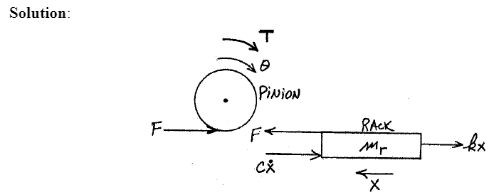The figure shows a rack-and-pinion gear in which a damping force and a spring force act against the rack. a. Determine the equivalent Inertia of the system using Kinetic Energy. b. Identify the equivalent rotational model of the system with the applied torque Tas the input variable and the angular displacement 0 as the output variable. Neglect any twist in the shaft. (Submit for Feedback in Connect) c. Convert the dynamic equation of the system to be written in term of x rather than e (ie, the torque Tis still the input variable but the linear displacement x is the output variable). What is the characteristic equation for each model? Comment on the expected behavior of the system whether the dynamic model is written terms of e or x.
The figure shows a rack-and-pinion gear in which a damping force and a spring force act against the rack. a. Determine the equivalent Inertia of the system using Kinetic Energy. b. Identify the equivalent rotational model of the system with the applied torque Tas the input variable and the angular displacement 0 as the output variable. Neglect any twist in the shaft. (Submit for Feedback in Connect) c. Convert the dynamic equation of the system to be written in term of x rather than e (ie, the torque Tis still the input variable but the linear displacement x is the output variable). What is the characteristic equation for each model? Comment on the expected behavior of the system whether the dynamic model is written terms of e or x.
Elements Of Electromagnetics
7th Edition
ISBN:9780190698614
Author:Sadiku, Matthew N. O.
Publisher:Sadiku, Matthew N. O.
ChapterMA: Math Assessment
Section: Chapter Questions
Problem 1.1MA
Related questions
Question

Transcribed Image Text:The figure shows a rack-and-pinion gear in which a damping force and a spring force act against the rack.
a. Determine the equivalent Inertia of the system using Kinetic Energy.
b. Identify the equivalent rotational model of the system with the applied torque Tas the input variable and the angular displacement 0 as the output variable.
Neglect any twist in the shaft. (Submit for Feedback in Connect)
c. Convert the dynamic equation of the system to be written in term of x rather than 0 (ie, the torque Tis still the input variable but the linear displacement x is the
output variable). What is the characteristic equation for each model? Comment on the expected behavior of the system whether the dynamic model is written terms
of e or x.
Expert Solution
Step 1

Trending now
This is a popular solution!
Step by step
Solved in 2 steps with 4 images

Knowledge Booster
Learn more about
Need a deep-dive on the concept behind this application? Look no further. Learn more about this topic, mechanical-engineering and related others by exploring similar questions and additional content below.Recommended textbooks for you

Elements Of Electromagnetics
Mechanical Engineering
ISBN:
9780190698614
Author:
Sadiku, Matthew N. O.
Publisher:
Oxford University Press

Mechanics of Materials (10th Edition)
Mechanical Engineering
ISBN:
9780134319650
Author:
Russell C. Hibbeler
Publisher:
PEARSON

Thermodynamics: An Engineering Approach
Mechanical Engineering
ISBN:
9781259822674
Author:
Yunus A. Cengel Dr., Michael A. Boles
Publisher:
McGraw-Hill Education

Elements Of Electromagnetics
Mechanical Engineering
ISBN:
9780190698614
Author:
Sadiku, Matthew N. O.
Publisher:
Oxford University Press

Mechanics of Materials (10th Edition)
Mechanical Engineering
ISBN:
9780134319650
Author:
Russell C. Hibbeler
Publisher:
PEARSON

Thermodynamics: An Engineering Approach
Mechanical Engineering
ISBN:
9781259822674
Author:
Yunus A. Cengel Dr., Michael A. Boles
Publisher:
McGraw-Hill Education

Control Systems Engineering
Mechanical Engineering
ISBN:
9781118170519
Author:
Norman S. Nise
Publisher:
WILEY

Mechanics of Materials (MindTap Course List)
Mechanical Engineering
ISBN:
9781337093347
Author:
Barry J. Goodno, James M. Gere
Publisher:
Cengage Learning

Engineering Mechanics: Statics
Mechanical Engineering
ISBN:
9781118807330
Author:
James L. Meriam, L. G. Kraige, J. N. Bolton
Publisher:
WILEY